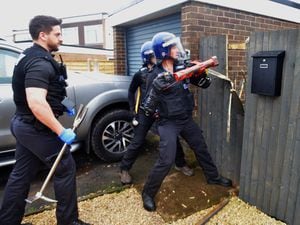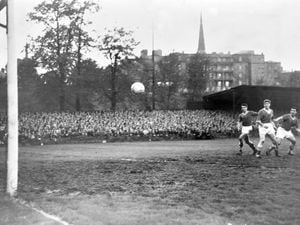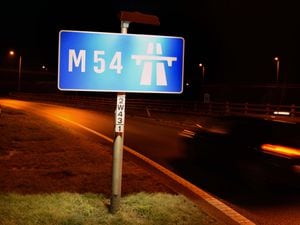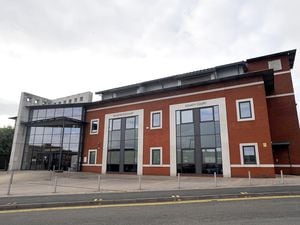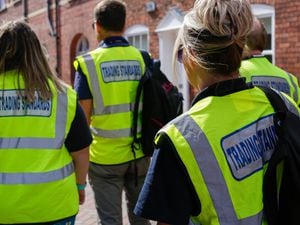The Falklands 40 years on: Another war born out of a dictator’s thirst for power
Forty years ago Britain fought a war for an island many had never heard of. And there was no guarantee it would triumph.
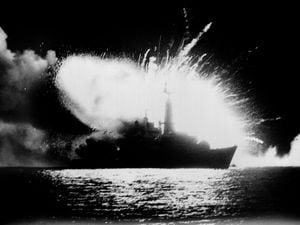
The warning signs had been there for a while. The bloodthirsty dictator had been threatening his neighbour for years, but nobody seriously believed he was mad enough to launch an invasion. And in turn, nobody in the dictator's inner circle seriously thought he would face any real opposition.
But just as is the case with Vladimir Putin and the Ukraine today, so it was 40 years ago with General Leopoldo Galtieri and the Falkland Islands. The moral being never underestimate the recklessness of autocrat bent on aggression.
Forty years ago on Saturday the nation woke to discover that British territory had been occupied for the first time since the Second World War. Few people at the time had heard of the Falkland Islands – there were many, even in the British military, who thought it was the Orkney Islands in northern Scotland which had come under attack.
But the news that British subjects were now under the jackboot of Galtieri's fascist junta sent a chill down the spine of a nation which thought those days had been banished forever in 1945.
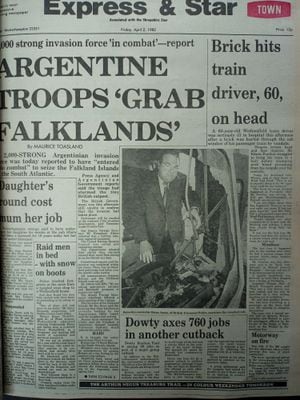
As the news unfolded, the public looked on in horror at pictures of Argentinian armoured cars driving triumphantly round the islands' capital, Port Stanley. There was the humiliation of Royal Marines being forced to lie face down in the dirt. But as the nation recoiled in disgust, Britain hit back in a way nobody expected. Within three days, the UK had dispatched the biggest armada since the Suez crisis in 1956, prompting the headline "The Empire Strikes Back" on the cover of Newsweek magazine.
Then prime minister Margaret Thatcher dispatched the task force, despite warnings from her own military advisers that an amphibious attack 8,000 miles from the British mainland could end in a bloody defeat.
Argentina had long claimed sovereignty over the islands, and in the late-1960s Harold Wilson's government appeared to be amenable to ceding them to Argentina. However when news of Wilson's plans became public, they were met with a furious backlash from the islanders, and the plans stalled.
The Foreign Office attempted to soften the islanders' stance by increasing ties between the Falklands and Argentina, creating an air link to the South American state in 1971, and granting its oil company a monopoly on the islands. But despite these efforts, the islanders remained resolutely opposed to Argentinian rule, while the Buenos Aires government was equally uncompromising when it came to its claims of sovereignty.
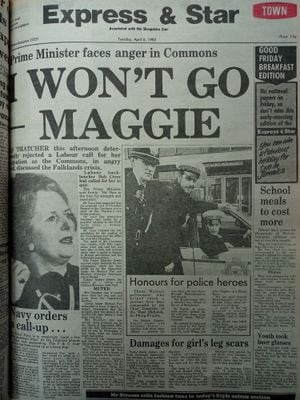
Given the state of Argentinian politics in the 1970s, it is perhaps not surprising the people of the Falklands were reluctant to cede British sovereignty. The death of President Juan Peron in July 1974 saw his widow Isabella assume office, and her chaotic rule was marked by economic collapse, political violence and repression.
A military coup in 1976 saw Peron replaced by a far-right junta, leading to the seven-year 'Dirty War' and the murder or disappearance of between 9,000 and 30,000 dissidents. The change of government did bring about a brief economic revival, but this was shortlived, and by the start of the 1980s the junta was extremely unpopular. Galtieri, who in December 1981 became the third Argentinian president in nine months. His attempts to placate growing calls for democracy by relaxing some of the repressive measures only led to a wave of protests.
With the junta's legitimacy hanging by a thread, Galtieri's right-hand man Admiral Jorge Anaya persuaded the dictator to try one final roll of the dice: the invasion of the Falklands.
Argentinian newspaper La Prensa speculated on a step-by-step plan beginning with cutting off supplies to the islands, with a full-scale invasion taking place towards the end of the year if the stand-off could not be resolved by diplomacy.
However, the tensions were ramped up on March 19 when a group of Argentinian scrap merchants, infiltrated by the Argentinian Marines, raised their country's flag on South Georgia, another British island in the South Atlantic. The Royal Navy sent ice-patrol ship HMS Endurance in response, and suspecting that Britain would beef up security in the area, the invasion was brought forward to April 2.
To describe the initial battle for the islands as one-sided would be something of an understatement. Defence of the capital fell to a single company of Royal Marines, and in the face of an onslaught from 2,000 Argentinians, they stood no chance.
Nicholas Barker, commanding officer of HMS Endurance, had warned several times that an attack was imminent, but met with little response. Barker believed plans by then defence secretary John Nott to withdraw the Endurance from the South Atlantic had also sent a message to Buenos Aires that Britain did not have the stomach for a battle.
Both Nott and foreign secretary Lord Carrington offered their resignations to PM Margaret Thatcher, but only Carrington's was accepted.
For Galtieri, the gamble appeared to have paid off. The protests outside the presidential palace turned to celebrations, and the dictator waved from the balcony telling cheering crowds how he had merely listened to the Argentinian people.
Britain responded by tabling a motion at the United Nations calling for Argentina to withdraw its troops, which was passed by 10 votes to one. Panama, which branded Britain the aggressor, voted against the motion, but crucially China and the USSR, which had power to veto the resolution, abstained.
The following day, Mrs Thatcher announced to parliament plans to retake the islands, sending a force of about 40 ships, headed by HMS Invincible, from Portsmouth. She told the Commons there was not "a shred of justification nor a scrap of legality" in Argentina's action. And Galtieri's aggression had transformed the mood of the British Government from one of seeking ways to offload the Falklands, to defending them at all costs.
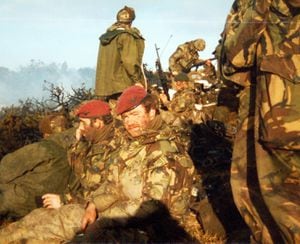
The ocean liner SS Canberra was requisitioned on its return from a world cruise on April 7, and set sale two days later with 3 Commando on board. The QE2 was also called into action, leaving Southampton on May12 with 5th Infantry Brigade on board. A total of 127 ships wer eventually dispatched to the South Atlantic.
Not everybody was convinced by Mrs Thatcher's resolve, though.
Dudley East MP John Gilbert, who had been a defence minister in Jim Callaghan's Labour government, said it would probably be impossible to win back the Falklands without the loss of British lives and ships.
"I would not be at all surprised if we had a different prime minister by the end of the summer," he said.
It was reported that the US Navy had concluded that retaking the islands was a "a military impossibility". Britain had 42 aircraft available for air combat operations, compared to Argentina's 122 jet fighters. Britain also lacked airborne early warning and control aircraft, and Argentina also had access to Exocet missiles and two Type 209 submarines.
On the other hand, a lack of suitable airbases made the Falklands difficult to defend. The islands had only three airfields, none of them able to support fast jets, forcing the Argentinians to launch major strikes from the mainland. The British Sea Harrier aircraft, which could take off and land from an aircraft carrier, gave Britain a crucial advantage in the air, shooting down 20 Argentinian aircraft in air-to-air combat without loss.
Britain retook South Georgia on April 25, and on April 30, the British Government imposed a 230-mile exclusion zone around the islands, rendering any ships or aircraft inside the zone liable to attack if they were aiding the Argentinian occupation.
On 1 May, the Argentinian cruiser General Belgrano was located in the exclusion zone by the British nuclear-powered submarine HMS Conqueror, and followed it until the following day, when it was about 12 hours away from the Task Force and just outside the exclusion zone. Admiral "Sandy" Woodward was aware of an Argentinian carrier group approaching from the other direction, and requested permission to attack the Belgrano to avoid being caught in a pincer movement. Permission was granted by the War Cabinet in London, and the Belgrano was sunk with the loss of 368 lives, although more than 700 men were eventually rescued.
The attack would prove controversial, with debate about the scope in law of the exclusion zone, and claims that the Belgrano was heading away from the conflict zone. But it also played a crucial role in the outcome of the conflict, with Argentina effectively withdrawing its navy from the conflict. The Belgrano's captain, Hector Bonzo, later revealed that far from exiting the theatre of war, he had been instructed to sink any British ships he could find, and said as far as he was concerned the attack was a legitimate act of war.
Two days later, though, it was the Royal Navy that was on the receiving end, when the destroyer HMS Sheffield was sunk by an Exocet missile strike. Twenty crew members were lost, and 24 seriously injured. It was the first time a Royal Navy ship had been destroyed since the Second World War.
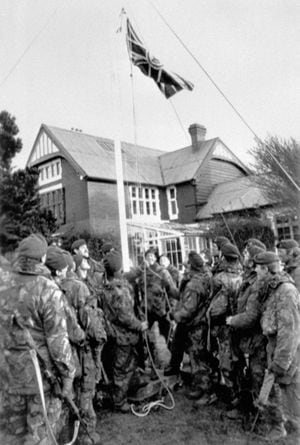
On May 21, British troops had safely landed at San Carlos Water, which became known as Bomb Alley as it came under fire from Argentinian planes. More ships were lost, but by this time the tide had turned.
The assaults on Darwin and Goose Green, on May 27 and 28, showed the superiority of Britain's highly trained forces over the demoralised conscripts of Argentina, as Britain claimed victory in the first land battles.
By June 1, more than 8,000 British troops were massed on the outskirts of Port Stanley, which was now coming under bombardment from the Harrier jump jets. Now, the result of the war looked a formality and British forces were in a position to bide their time for the final push. On the night of June 11, days of painstaking reconnaissance and logistic build-up, an attack was launched on the capital. The Argentinian commander in Stanley, Brigade General Mario Menéndez, surrendered to Major General Jeremy Moore on June 14, which was declared by islanders as Liberation Day.
It was a total humiliation for the Argentinian forces, with 14,800 men forced to surrender, many suffering from exposure, exhaustion and frostbite.
Journalist Max Hastings described walking through Argentinian lines with his hands in the air, to be greeted with a warm welcome by Stanley's Catholic priest Monsignor Daniel Spraggon.
"As we talked, thousands of dejected Argentine troops marched past us down the main street to prepare to surrender," he wrote.
A total of 907 people were killed in the conflict: 649 Argentinians, 255 British servicemen, and three civilians on the island.
Four days later, Galtieri was removed from power, and a process put in place of restoring democracy to Argentina. In 1986 he was jailed for 12 years for mishandling, the war, although he was pardoned by President Carlos Menem three years later.

